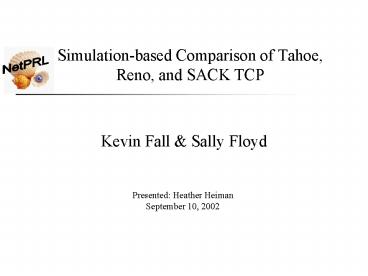Simulationbased Comparison of Tahoe, Reno, and SACK TCP - PowerPoint PPT Presentation
1 / 21
Title:
Simulationbased Comparison of Tahoe, Reno, and SACK TCP
Description:
Tahoe TCP added Slow-Start, Congestion Avoidance, and Fast Retransmit Algorithms ... Protocols that retransmit all unacknowledged data at a single time can overwhelm ... – PowerPoint PPT presentation
Number of Views:450
Avg rating:3.0/5.0
Title: Simulationbased Comparison of Tahoe, Reno, and SACK TCP
1
Simulation-based Comparison of Tahoe, Reno, and
SACK TCP
- Kevin Fall Sally Floyd
Presented Heather Heiman September 10, 2002
2
TCP Versions
- Tahoe TCP
- Reno TCP
- New-Reno TCP
- SACK TCP
3
Tahoe TCP
- First implemented in 4.3 BSD in 1988
- Earlier TCP implementations used a go-back-n
model to control network congestion - Tahoe TCP added Slow-Start, Congestion Avoidance,
and Fast Retransmit Algorithms
4
Slow-Start
- The congestion window (cwnd) is increased by 1
for every acknowledgement received, therefore the
cwnd increases exponentially - Slow-Start continues until the cwnd is greater
than or equal to the threshold - Threshold cutoff point based on the last
occurring congestion - Once the cwnd is greater than or equal to the
threshold, congestion avoidance begins
5
Congestion Avoidance
- Instead of increasing the cwnd by 1 each time an
acknowledgement is received, the congestion
avoidance algorithm increases the cwnd by 1 each
RTT - cwnd grows linearly
6
Fast Retransmit
- When a set number of duplicate acknowledgements
have been received for the same packet, the data
sender retransmits the packet without waiting for
the retransmit timer to expire
7
Reno TCP
- Same as Tahoe TCP, but changed Fast Retransmit to
include Fast Recovery - Fast Recovery is entered once a certain number of
duplicate acks have been received (generally the
threshold is set to 3) - Like Fast Retransmit, the sender retransmits the
packet that has been lost, but instead of
slow-starting the cwnd is cut in half and then
the sender counts duplicate acks to determine
when to send packets
8
Reno TCP
- Senders usable window min(awin, cwnd ndup)
- awin receivers advertised window
- cwnd senders congestion window
- ndup number of duplicate acks (remains at 0
until the number of duplicate acks reaches the
threshold) - During Fast Recovery, the sender increases its
usable window by the number of duplicate acks
received
9
Reno TCP
- Fast Recovery is exited when an ack is received
asking for new data - Fast Recovery is optimal for the case when only
one packet is lost from a window of data - The best rate Reno TCP can retransmit packets is
the rate of 1 per RTT
10
New-Reno TCP
- Same as Reno TCP, but implements a modification
to the senders algorithm during Fast Recovery - In Reno TCP, if a partial ack is received, Fast
Recovery is exited and the usable window size is
reset to the cwnd size - In New-Reno TCP, if a partial ack is received, it
indicates to the sender that the packet numbered
immediately after the acked packet has been lost
11
New-Reno TCP
- The packet is immediately retransmitted without
waiting for the retransmit timer to expire - New-Reno exits Fast Recovery only when all the
outstanding data when it began has been acked - A maxburst parameter is used to limit the
number of packets that can be sent in response to
a single ack, even if the cwnd would allow more
packets to be sent - Maxburst four when outside of Fast Recovery
- Maxburst two during Fast Recovery
12
SACK TCP
- Explained in detail in RFC 2018
- Uses SACK blocks that contain information about
received and queued non-contiguous data packets - The first block is required to keep track of the
most recently received data sequence - SACK TCP uses the same algorithms for adjusting
the cwnd - The main difference between SACK TCP and New-Reno
TCP is during multiple packet loss
13
SACK TCP
- During Fast Recovery, SACK has an extra variable
called pipe - pipe is used to keep track of the number of
outstanding packets - New or retransmitted data is only sent when pipe
lt cwnd - When a packet is sent, pipe is incremented by 1
- When a duplicate ack is received with a SACK
option indicating new data has been received,
pipe is decremented by 1
14
SACK TCP
- If a partial ack is received, pipe is decreased
by 2 - This represents the original packet sent and the
retransmitted packet - For partial acks, the sender never recovers
slower than Slow-Start
15
SACK TCP
- SACK TCP keeps track of all acks from previous
SACK options using a data structure called the
scoreboard - When the sender is allowed to send a packet, it
retransmits the next packet on the list that the
receiver is thought to have not received - If there are no packets on the list, then a new
packet is sent
16
SACK TCP
- If a retransmitted packet is lost, it is detected
when the retransmit timer expires - When this occurs, the packet is retransmitted
- Then SACK TCP goes into Slow-Start
17
Simulation Results
- One Packet Loss Tahoe TCP doesnt perform as
well as the other versions due to the fact it
does slow-start after packet loss - Two Packet Losses Reno TCP doesnt do as well as
New-Reno and SACK - Multiple Packet Losses SACK TCP performs the
best out of all the algorithms
18
TCP Option Numbers
19
Problems w/TCP
- Unnecessary traffic due to retransmissions
- Protocols that retransmit all unacknowledged data
at a single time can overwhelm the network. - Unsuccessful connections
- The load on network servers can be very high when
processing unsuccessful connections - Beginning Connections without a Slow-Start can
cause bursts of traffic
20
(No Transcript)
21
(No Transcript)































